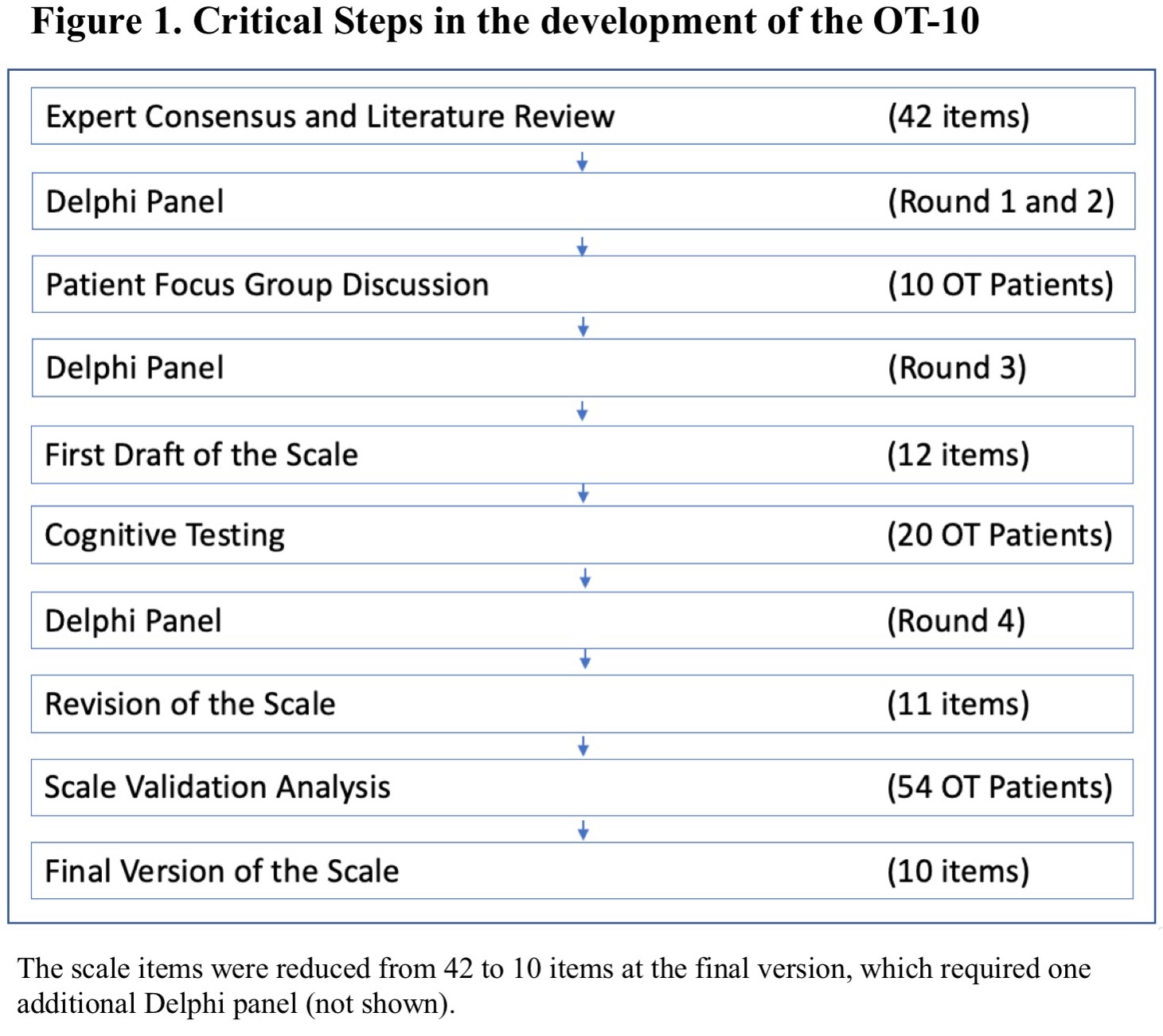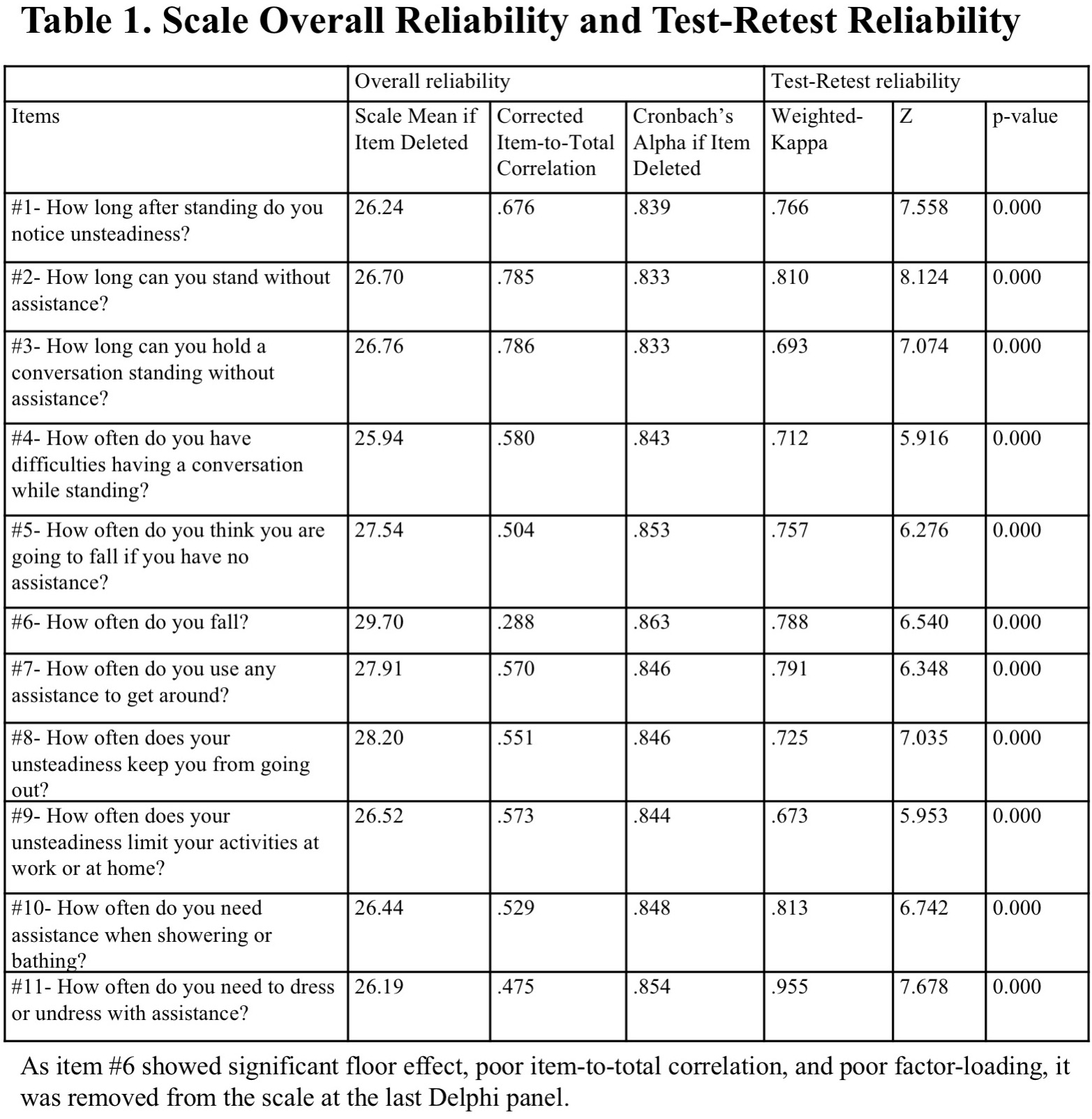Category: Rating Scales
Objective: To develop and validate a severity and disability self-administered scale for orthostatic tremor (OT).
Background: OT is characterized by a 13-18 Hz tremor in weight-bearing limbs during standing that attenuates on leaning against an object and disappears on sitting or walking. [1] Studies have relied on electromyography, total standing time, or a combination of patient and physician-rated questionnaires as surrogate measures of severity and disability in the absence of a validated clinical scale. [2]
Method: This multicenter scale development and validation trial followed a multi-step Delphi method for consensus. [3] Step one was the generation of the initial 42-item pool through literature review and expert opinion. Step two was first scale draft via patients’ focus groups. Step three was formal cognitive debriefing. Step four was psychometric testing for acceptability and distributional skewness of items, global scale reliability, construct validity, and convergent validity anchored on the examiner’s Clinical Global Impression Score (CGI) [figure1]. Steps two and three used a Framework method for qualitative data analysis, [4] while step four used Classical Test Theory. [5] A 4.5:1 subject-to-item ratio was used for sample size. [6]
Results: Eleven items ranked on a Likert scale from 0 (no disability/severity) to 5 (maximal disability/severity) were evaluated in 54 OT patients (16 men and 38 women; mean age, 69.17 ± 9.64 years; disease duration, 13.83 ± 11.24 years) to probe severity and disability over the immediately preceding one-week period. The 11-item scale showed good internal consistency (Cronbach’s alpha= 0.863) and acceptable (> 0.40) item-to-total correlation [table1]. However, one item was removed at the final Delphi panel due to significant floor effect, poor item-to-total correlation, and poor factor-loading. The test-retest reliability at 2 weeks was excellent (two-way random intraclass correlation coefficient > 0.90), and the individual item test-retest reliability showed good agreement, with a threshold weighted kappa > 0.60 for all items. Exploratory factor analyses revealed a parsimonious two-factor construct accounting for 57.7% of the scale’s variance. A correlation was found between the OT-10 score and the CGI.
Conclusion: The self-administered OT-10 scale is valid and reliable for capturing OT-related severity and disability.
References: 1.Ganos C, Maugest L, Apartis E, et al. The long-term outcome of orthostatic tremor. J. Neurol. Neurosurg. Psychiatry 2016;87(2):167–72. 2.Hellriegel H, Raethjen J, Deuschl G, Volkmann J. Levetiracetam in primary orthostatic tremor: a double-blind placebo-controlled crossover study. Mov Disord 2011;26(13):2431–4. 3.Dalkey N, Helmer O. An Experimental Application of the DELPHI Method to the Use of Experts. Manage Sci 1963;9(3):458–67. 4.Gale NK, Heath G, Cameron E, Rashid S, Redwood S. Using the framework method for the analysis of qualitative data in multi-disciplinary health research. BMC Med Res Methodol 2013;13(1). 5.DeVellis, R. Scale Development: Theory and applications, London, SAGE publications, 2nd edition, 2003, pp 171. 6.Anthoine E, Moret L, Regnault A, Sébille V, Hardouin J-B. Sample size used to validate a scale: a review of publications on newly-developed patient reported outcomes measures. Health Qual Life Outcomes 2014;12:176.
To cite this abstract in AMA style:
J. Vizcarra, A. Merola, D. Torres-Russotto, G. Stebbins, A. Wagle Shukla, A. Hassan, L. Marsili, J. Krauss, R. Elble, G. Deuschl, A. Espay. Development and Validation of the Orthostatic Tremor Severity and Disability Scale (OT-10) [abstract]. Mov Disord. 2020; 35 (suppl 1). https://www.mdsabstracts.org/abstract/development-and-validation-of-the-orthostatic-tremor-severity-and-disability-scale-ot-10/. Accessed April 1, 2025.« Back to MDS Virtual Congress 2020
MDS Abstracts - https://www.mdsabstracts.org/abstract/development-and-validation-of-the-orthostatic-tremor-severity-and-disability-scale-ot-10/


